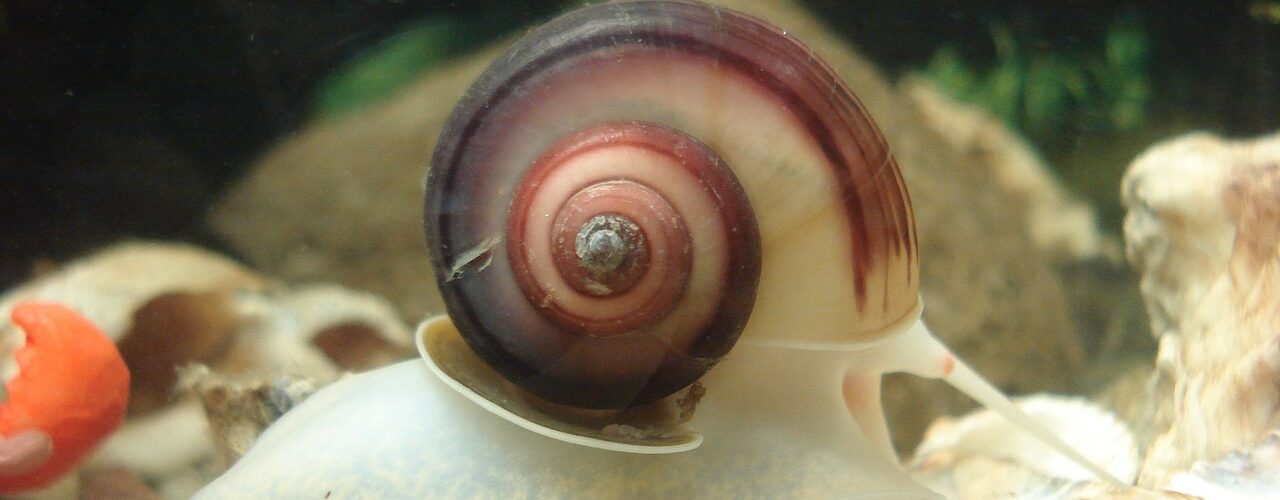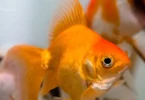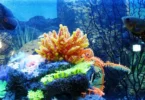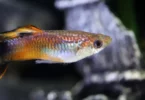Last Updated on July 26, 2023 by Jakob
Welcome to the fascinating world of the Nerite snail, a small and alluring creature found in both freshwater and marine environments across the globe. With their unique appearance, remarkable behaviors, and valuable contributions to aquatic ecosystems (for those that want these as pets), Nerite snails have captured the attention of both hobbyists and researchers alike.
Nerite snails belong to the family Neritidae, a diverse group of gastropods known for their beautiful shells and intriguing habits. These small, spiral-shaped mollusks showcase an array of captivating colors and patterns on their shells, making them a popular choice for aquarium enthusiasts seeking natural beauty and a touch of elegance in their tanks.
Beyond their aesthetic appeal, Nerite snails play a pivotal role in maintaining the ecological balance of their habitats. As voracious algae eaters, they efficiently graze on the aquatic vegetation, helping to keep algae growth in check. In this symbiotic relationship, they not only promote healthier water conditions but also provide a source of sustenance for other aquatic organisms.
Throughout this introduction, we will delve into the various species of Nerite snails, their distinctive features, habitat preferences, and intriguing behaviors. From their unique reproductive strategies to their ability to adapt to diverse environments, the Nerite snail’s captivating world will undoubtedly leave you awestruck.
Whether you’re a passionate aquarist looking to enrich your tank’s ecosystem or simply curious about the wonders of marine life, join us as we unravel the enigmatic and captivating universe of the Nerite snail. Prepare to be amazed by the sheer brilliance of this unassuming yet extraordinary gastropod species.
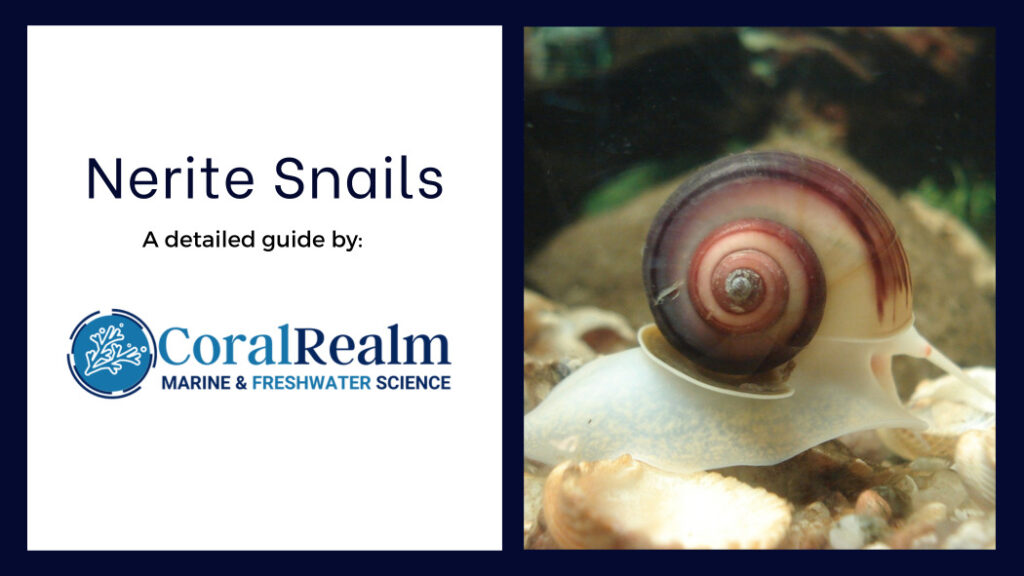
IN THIS ARTICLE
Species Overview
The Nerite snail, scientifically known as Neritina natalensis, are members of the family Neritidae, these small mollusks have intrigued scientists and nature enthusiasts alike, leading to numerous studies to better understand and identify the various species within this family.
Identifying Nerite snails has been a subject of interest for researchers. With their wide range of colors, patterns, and shell shapes, scientists have relied on a combination of physical characteristics and genetic analysis to differentiate between the various species. The intricate patterns on their shells and the size and shape of the aperture are some of the key factors used to distinguish different Nerite snail species. Moreover, advancements in DNA sequencing technology have allowed for more accurate species identification and classification.
Nerite snails are primarily herbivorous creatures, spending their time diligently grazing on algae and biofilm that coat rocks, plant leaves, and other submerged surfaces. Their unique radula, a specialized feeding organ, equipped with tiny teeth, enables them to scrape off algae and other microorganisms efficiently. This algae-eating behavior not only sustains the snails but also contributes significantly to maintaining a healthy balance in aquatic ecosystems, as they help control algae growth and promote water quality in their respective habitats. Whether in freshwater rivers, lakes, brackish estuaries, or marine coastal areas, Nerite snails play a crucial role in the delicate ecological web that supports diverse aquatic life.

Michal Maňas, CC BY 4.0, via Wikimedia Commons
Lifespan of a Nerite Snail
The lifespan of Nerite snails can vary depending on several factors, including species, environmental conditions, and overall health. On average, Nerite snails tend to have a relatively short lifespan compared to some other aquarium or aquatic organisms.
Several factors can influence the lifespan of Nerite snails: in captivity:
- Water Quality: Clean and stable water parameters are crucial for the well-being and longevity of Nerite snails. Poor water quality with high levels of ammonia, nitrites, or nitrates can stress the snails and reduce their lifespan.
- Diet: Providing a balanced diet rich in algae and other essential nutrients is vital for the snails’ health. A varied and nutritious diet ensures they receive the necessary energy and minerals to thrive.
- Habitat: A well-maintained aquarium or aquatic environment, with appropriate hiding spots, suitable substrate, and sufficient places to graze on algae, contributes to the snails’ overall well-being and longevity.
- Predators: In natural environments, Nerite snails may face predation from various aquatic animals, which can impact their lifespan. In captivity, providing a safe environment, free from potential predators, can extend their lifespan.
- Reproduction: Some Nerite snail species are unable to reproduce in freshwater aquariums, which can be beneficial for their lifespan, as reproducing can be taxing on their energy reserves.
It’s essential to research the specific species of Nerite snail you have and tailor their care accordingly to optimize their lifespan. Providing a healthy and nurturing environment will not only ensure their longevity but also allow you to enjoy their fascinating behaviors and algae-eating benefits for a more extended period.
Nerite Snail Ecology and distribution
Nerite snails have a diverse ecology and are distributed in a wide range of habitats, both in freshwater and marine environments. Their ecological roles and distribution have been the subject of several research papers.
Ecology of Nerite Snails: Nerite snails play crucial roles in aquatic ecosystems, especially in freshwater environments. Their primary ecological contribution lies in their algae-eating behavior. As efficient grazers, they help control algae growth on various surfaces, including rocks, submerged vegetation, and driftwood. By consuming algae, Nerite snails contribute to maintaining healthy water conditions and preventing excessive algae blooms that can lead to oxygen depletion and harm other aquatic organisms.
Additionally, Nerite snails serve as important prey items for various aquatic predators, such as fish, birds, and other invertebrates. Their presence in the food web supports the biodiversity and ecological balance of their respective habitats.
Distribution in the Wild: Nerite snails are found in a wide variety of aquatic environments across the world. Their distribution ranges from freshwater rivers, streams, and lakes to brackish estuaries and coastal marine areas. Some species are more specialized and confined to specific habitats, while others display a more generalist distribution, adapting to varying salinity levels.
Appearance
The appearance of a Nerite snail is striking and captivating, making them a popular choice for aquarium enthusiasts seeking an aesthetically pleasing addition to their tanks. While there are several species of Nerite snails, they share some common features in terms of their appearance.
1. Shell: The most prominent and defining characteristic of a Nerite snail is its spiral-shaped shell. The shell’s coloration can vary widely among species, ranging from dark brown and black to vibrant shades of yellow, orange, red, green, or even blue. The shells often feature intricate and eye-catching patterns, such as stripes, spots, or swirls, which add to their visual appeal.
2. Size: Nerite snails are relatively small in size, with most species growing to be around 1 to 2 centimeters in diameter. Some larger species can reach up to 3 centimeters, but they generally remain compact and fit comfortably in aquarium settings.
3. Body: The snail’s soft body is housed within the protective shell. It consists of a muscular foot that helps them move and cling to surfaces, along with two prominent sensory tentacles on their head. These tentacles are equipped with eyes at their tips, allowing Nerite snails to detect light and movement in their environment.
4. Operculum: Located at the opening of the shell, the operculum is a protective trapdoor-like structure made of a hard, horn-like substance. Nerite snails use their operculum to seal the shell when they retract inside, providing an extra layer of protection against potential predators and adverse conditions.
5. Foot Color: The color of the snail’s foot can vary among species, but it is generally a lighter hue compared to their shells. The foot is often seen when the snail is actively moving or grazing on surfaces, and it contrasts nicely against the substrate.
Overall, Nerite snails boast a stunning combination of vibrant colors, intricate patterns, and a unique spiral shape that makes them a delightful addition to aquariums or a fascinating sight in their natural habitats. Their visually appealing appearance, coupled with their algae-eating behavior, makes them an excellent choice for maintaining a clean and balanced aquatic ecosystem.
Nerite Snails Fact Sheet – Habitat, Origin and Care Guide
Welcome to the fascinating world of the Nerite snail, a small and alluring creature found in both freshwater and marine environments across the globe. With their unique appearance, remarkable behaviors, and valuable contributions to aquatic ecosystems (for those that want these as pets), Nerite snails have captured the attention of both hobbyists and researchers alike.
Nerite snails belong to the family Neritidae, a diverse group of gastropods known for their beautiful shells and intriguing habits. These small, spiral-shaped mollusks showcase an array of captivating colors and patterns on their shells, making them a popular choice for aquarium enthusiasts seeking natural beauty and a touch of elegance in their tanks.
Beyond their aesthetic appeal, Nerite snails play a pivotal role in maintaining the ecological balance of their habitats. As voracious algae eaters, they efficiently graze on the aquatic vegetation, helping to keep algae growth in check. In this symbiotic relationship, they not only promote healthier water conditions but also provide a source of sustenance for other aquatic organisms.
Throughout this introduction, we will delve into the various species of Nerite snails, their distinctive features, habitat preferences, and intriguing behaviors. From their unique reproductive strategies to their ability to adapt to diverse environments, the Nerite snail’s captivating world will undoubtedly leave you awestruck.
Whether you’re a passionate aquarist looking to enrich your tank’s ecosystem or simply curious about the wonders of marine life, join us as we unravel the enigmatic and captivating universe of the Nerite snail. Prepare to be amazed by the sheer brilliance of this unassuming yet extraordinary gastropod species.
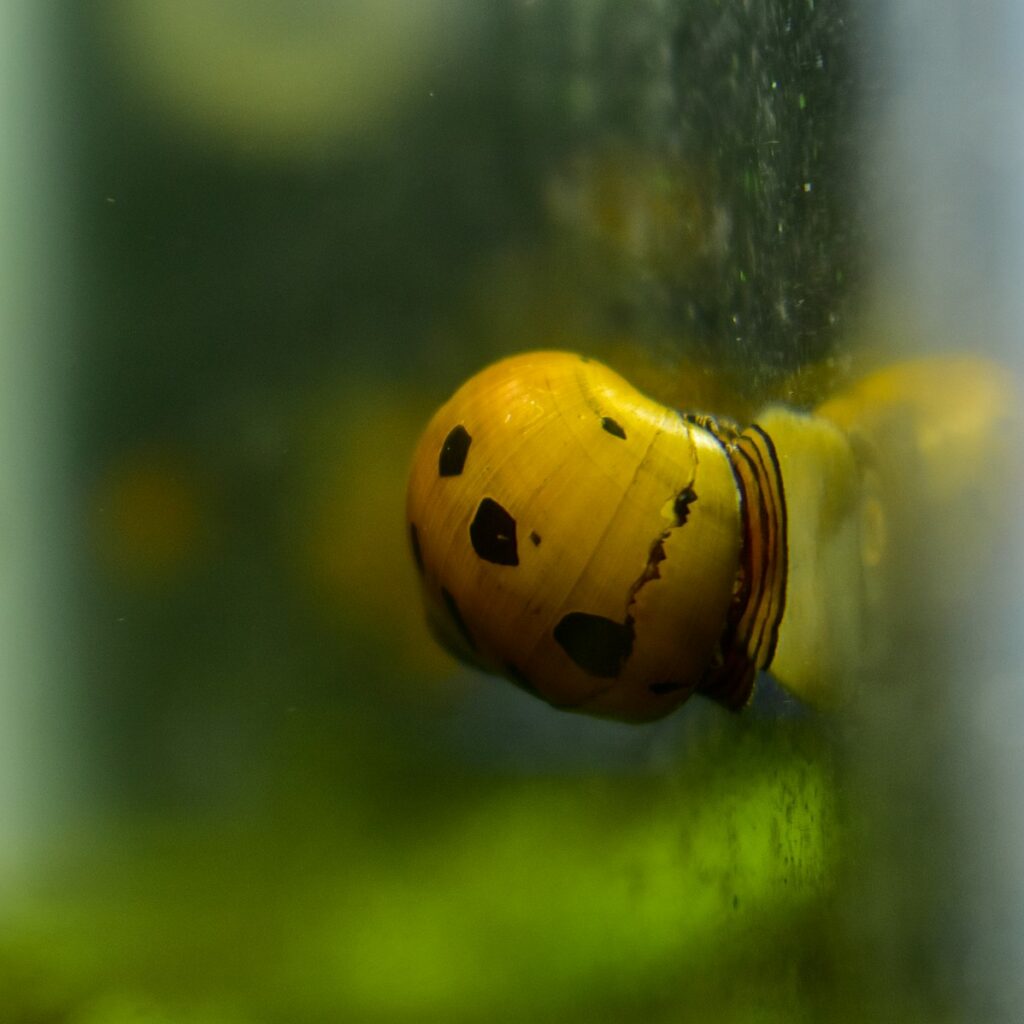
Atulbhats, CC BY-SA 4.0, via Wikimedia Commons
Species Overview
The Nerite snail, scientifically known as Neritina natalensis, are members of the family Neritidae, these small mollusks have intrigued scientists and nature enthusiasts alike, leading to numerous studies to better understand and identify the various species within this family.
Identifying Nerite snails has been a subject of interest for researchers. With their wide range of colors, patterns, and shell shapes, scientists have relied on a combination of physical characteristics and genetic analysis to differentiate between the various species. The intricate patterns on their shells and the size and shape of the aperture are some of the key factors used to distinguish different Nerite snail species. Moreover, advancements in DNA sequencing technology have allowed for more accurate species identification and classification.
Nerite snails are primarily herbivorous creatures, spending their time diligently grazing on algae and biofilm that coat rocks, plant leaves, and other submerged surfaces. Their unique radula, a specialized feeding organ, equipped with tiny teeth, enables them to scrape off algae and other microorganisms efficiently. This algae-eating behavior not only sustains the snails but also contributes significantly to maintaining a healthy balance in aquatic ecosystems, as they help control algae growth and promote water quality in their respective habitats. Whether in freshwater rivers, lakes, brackish estuaries, or marine coastal areas, Nerite snails play a crucial role in the delicate ecological web that supports diverse aquatic life.
Lifespan of a Nerite Snail
The lifespan of Nerite snails can vary depending on several factors, including species, environmental conditions, and overall health. On average, Nerite snails tend to have a relatively short lifespan compared to some other aquarium or aquatic organisms.Shortcode
Several factors can influence the lifespan of Nerite snails: in captivity:
- Water Quality: Clean and stable water parameters are crucial for the well-being and longevity of Nerite snails. Poor water quality with high levels of ammonia, nitrites, or nitrates can stress the snails and reduce their lifespan.
- Diet: Providing a balanced diet rich in algae and other essential nutrients is vital for the snails’ health. A varied and nutritious diet ensures they receive the necessary energy and minerals to thrive.
- Habitat: A well-maintained aquarium or aquatic environment, with appropriate hiding spots, suitable substrate, and sufficient places to graze on algae, contributes to the snails’ overall well-being and longevity.
- Predators: In natural environments, Nerite snails may face predation from various aquatic animals, which can impact their lifespan. In captivity, providing a safe environment, free from potential predators, can extend their lifespan.
- Reproduction: Some Nerite snail species are unable to reproduce in freshwater aquariums, which can be beneficial for their lifespan, as reproducing can be taxing on their energy reserves.
It’s essential to research the specific species of Nerite snail you have and tailor their care accordingly to optimize their lifespan. Providing a healthy and nurturing environment will not only ensure their longevity but also allow you to enjoy their fascinating behaviors and algae-eating benefits for a more extended period.
Nerite Snail Ecology and distribution
Nerite snails have a diverse ecology and are distributed in a wide range of habitats, both in freshwater and marine environments. Their ecological roles and distribution have been the subject of several research papers.
Ecology of Nerite Snails: Nerite snails play crucial roles in aquatic ecosystems, especially in freshwater environments. Their primary ecological contribution lies in their algae-eating behavior. As efficient grazers, they help control algae growth on various surfaces, including rocks, submerged vegetation, and driftwood. By consuming algae, Nerite snails contribute to maintaining healthy water conditions and preventing excessive algae blooms that can lead to oxygen depletion and harm other aquatic organisms.
Additionally, Nerite snails serve as important prey items for various aquatic predators, such as fish, birds, and other invertebrates. Their presence in the food web supports the biodiversity and ecological balance of their respective habitats.
Distribution in the Wild: Nerite snails are found in a wide variety of aquatic environments across the world. Their distribution ranges from freshwater rivers, streams, and lakes to brackish estuaries and coastal marine areas. Some species are more specialized and confined to specific habitats, while others display a more generalist distribution, adapting to varying salinity levels.
Appearance
The appearance of a Nerite snail is striking and captivating, making them a popular choice for aquarium enthusiasts seeking an aesthetically pleasing addition to their tanks. While there are several species of Nerite snails, they share some common features in terms of their appearance.
1. Shell: The most prominent and defining characteristic of a Nerite snail is its spiral-shaped shell. The shell’s coloration can vary widely among species, ranging from dark brown and black to vibrant shades of yellow, orange, red, green, or even blue. The shells often feature intricate and eye-catching patterns, such as stripes, spots, or swirls, which add to their visual appeal.
2. Size: Nerite snails are relatively small in size, with most species growing to be around 1 to 2 centimeters in diameter. Some larger species can reach up to 3 centimeters, but they generally remain compact and fit comfortably in aquarium settings.
3. Body: The snail’s soft body is housed within the protective shell. It consists of a muscular foot that helps them move and cling to surfaces, along with two prominent sensory tentacles on their head. These tentacles are equipped with eyes at their tips, allowing Nerite snails to detect light and movement in their environment.
4. Operculum: Located at the opening of the shell, the operculum is a protective trapdoor-like structure made of a hard, horn-like substance. Nerite snails use their operculum to seal the shell when they retract inside, providing an extra layer of protection against potential predators and adverse conditions.
5. Foot Color: The color of the snail’s foot can vary among species, but it is generally a lighter hue compared to their shells. The foot is often seen when the snail is actively moving or grazing on surfaces, and it contrasts nicely against the substrate.
Overall, Nerite snails boast a stunning combination of vibrant colors, intricate patterns, and a unique spiral shape that makes them a delightful addition to aquariums or a fascinating sight in their natural habitats. Their visually appealing appearance, coupled with their algae-eating behavior, makes them an excellent choice for maintaining a clean and balanced aquatic ecosystem.
Nerite Snails in the aquarium environment:
Nerite snails are captivating and beneficial additions to aquariums, bringing both beauty and functionality to aquatic environments. As algae-eating specialists, they play a crucial role in maintaining a clean and balanced ecosystem by grazing on algae and biofilm. Their striking shell patterns and peaceful nature make them popular among hobbyists, while their voracious appetite for algae helps keep tanks aesthetically pleasing and healthy. In the following sections, we will delve deeper into the care, behavior, and interactions of Nerite snails in the aquarium, offering insights into providing them with the best possible environment for their well-being and enjoyment. Whether you’re a seasoned aquarium enthusiast or a beginner, learning more about these delightful gastropods will undoubtedly enhance your appreciation for their unique contribution to aquatic life.
Breeding Nerite Snails
Nerite snail breeding is an intriguing and complex process, and it’s important to note that not all Nerite snail species reproduce in freshwater aquariums. Many Nerite snails are strictly marine or require brackish water conditions for successful breeding. However, some freshwater Nerite species, such as the Zebra Nerite (Neritina natalensis), may attempt to breed in captivity.
In the case of freshwater Nerite snails, successful breeding is challenging, and their reproductive strategies have evolved to survive in their native environments. Female Nerite snails typically lay small, gelatinous eggs on hard surfaces such as rocks, glass, or plant leaves. These eggs are usually difficult to spot due to their translucent appearance and small size.
One significant challenge with Nerite snail breeding in freshwater aquariums is that the eggs often require brackish or marine conditions to hatch and develop into viable larvae. Consequently, in freshwater aquariums, the eggs of Nerite snails usually do not hatch, and the larvae do not survive, leading to a lack of successful reproduction.
To encourage Nerite snail breeding, providing conditions closer to their natural habitat is essential. This means maintaining a brackish water environment or gradually transitioning the aquarium from freshwater to slightly brackish conditions. However, it’s crucial to research the specific breeding requirements of the Nerite species in question, as each may have unique preferences and needs.
In conclusion, while Nerite snails are captivating creatures with fascinating reproductive behaviors, breeding them successfully in freshwater aquariums can be a challenging endeavor. Due to their specific requirements for hatching and larval development, many Nerite snail species primarily reproduce in marine or brackish environments. If you’re interested in witnessing Nerite snail breeding, providing conditions that mimic their natural habitat is crucial to increase the likelihood of successful reproduction. However, for most hobbyists, the primary allure of Nerite snails lies in their beautiful shells, beneficial algae-eating habits, and low-maintenance care, rather than their breeding activities.
Can Nerite Snails Live with Betta Fish?
Yes, Nerite snails can generally live with Betta fish in the same aquarium. However, it’s important to consider a few factors for a harmonious coexistence.
Firstly, ensure the tank is large enough to accommodate both species comfortably, providing ample space for them to establish their territories.
Secondly, be mindful of the Betta fish’s temperament, as they can be territorial and aggressive, especially towards fish that resemble other Betta fish. Fortunately, Nerite snails’ distinct appearance and behavior usually do not trigger aggression from Bettas.
Thirdly, the sturdy shells of Nerite snails offer protection against potential nips or bites from Betta fish. Unlike some other snail species, Nerite snails are less likely to become targets for aggression due to their hard shells.
With appropriate tank size, observation of the Betta’s behavior, and consideration of the Nerite snails’ well-being, keeping them together can be a successful and enjoyable experience in your aquarium.
Recommended Tank Mates For Nerite Snails
Nerite snails are generally peaceful and make great tank mates for various freshwater and brackish water aquariums. When choosing tank mates for Nerite snails, it’s essential to consider the snails’ specific needs and preferences. Here are some compatible tank mates to consider:
1. Peaceful Community Fish: Many peaceful community fish can coexist peacefully with Nerite snails. Some suitable options include small schooling fish like:
- Barbs
- Tetras
- Rasboras
- Danios.
- Cory catfish
- Otocinclus
- Neon tetras and others
- Bristlenose plecos
Other good choices include peaceful bottom-dwelling fish like Corydoras catfish or small non-aggressive species of loaches like Kuhli loaches.
2. Shrimp: Dwarf shrimp, such as Cherry shrimp or Amano shrimp, are excellent tank mates for Nerite snails. They generally have similar requirements and are peaceful, making them a great addition to the same environment.
3. Snail Species: Some other snail species, like Mystery snails or Rabbit snails, can cohabitate with Nerite snails without any major issues. Just be mindful of the overall snail population to avoid overcrowding.
4. Small, Peaceful Invertebrates: In addition to shrimp, other peaceful invertebrates like small freshwater clams or small freshwater crabs can be compatible tank mates for Nerite snails.
When introducing any new tank mates, it’s essential to monitor the interactions closely, especially if you have Betta fish or other potentially aggressive species in the aquarium. Providing ample hiding spots, plants, and decorations can help create a well-structured environment that allows each species to establish their territories and feel secure.
As with any tank mate selection, always research the specific needs and behaviors of the species you plan to keep together to ensure they are compatible and can thrive in the same aquarium environment.
Sub Species of Nerite Snails
There are several types of Nerite snails, each with its unique appearance and habitat preferences. Here are some of the most common and popular types of Nerite snails:
1. Zebra Nerite (Neritina natalensis):
One of the most well-known and widely available species. It features striking black and gold zebra-like stripes on its shell, making it a popular choice for aquarium enthusiasts.
2. Tiger Nerite (Neritina turrita):
The Tiger Nerite has a beautiful pattern of dark, jagged stripes on its shell, resembling the stripes of a tiger. Its unique appearance adds an element of visual interest to any aquarium.
3. Olive Nerite (Neritina reclivata):
The Olive Nerite snail showcases a smooth, olive-green shell with occasional black markings or stripes. It is a popular species for algae control in aquariums due to its voracious appetite for algae.
4. Horned Nerite (Clithon corona):
The Horned Nerite features a distinctive shell with small, horn-like appendages on its edges, giving it a unique and eye-catching appearance.
5. Red Racer Nerite (Vittina waigiensis):
The Red Racer Nerite is known for its bright red or reddish-brown shell coloration, making it stand out among other Nerite snail species.
6. Sun Thorn Nerite (Clithon retropictus):
The Sun Thorn Nerite has a unique shell with rows of spiky thorns, which give it a fascinating and striking appearance.
7. Black Racer Nerite (Neritina pulligera):
The Black Racer Nerite is predominantly black with occasional lighter bands on its shell, creating an appealing contrast.
8. Horned Thorn Nerite (Clithon diadema):
The Horned Thorn Nerite showcases an intriguing shell adorned with long, horn-like thorns, making it a visually captivating addition to an aquarium.
It’s important to note that the availability of different Nerite snail species can vary depending on your location and the local pet trade. Each type of Nerite snail has its own unique traits and patterns, making them a popular choice for aquarium enthusiasts looking to add diversity and beauty to their tanks.
Nerite Snail Size:
Nerite snails are relatively small aquatic creatures, and their size can vary slightly depending on the species. On average, most Nerite snails grow to be about 1 to 2 centimeters (0.4 to 0.8 inches) in diameter. Some larger species may reach up to 3 centimeters (1.2 inches), but they generally remain compact and petite. Due to their small size, Nerite snails are well-suited for aquariums of various sizes and can thrive in both freshwater and marine environments, largely going undetected.
Nerite Snail Care
Nerite snails are fascinating and low-maintenance creatures that make excellent additions to freshwater and brackish water aquariums. Proper care ensures their well-being and allows them to thrive in their environments. Here are essential care considerations for Nerite snails:
Tank Size: A suitable tank size for Nerite snails depends on the number of snails you plan to keep. As they are relatively small, a 10-gallon aquarium or larger should provide ample space for a small group of Nerite snails. Ensure the tank has a secure lid to prevent escapes, as Nerite snails can be excellent climbers.
Water Parameters: Nerite snails prefer stable and clean water conditions. Keep ammonia, nitrites, and nitrates at minimal levels, as these can be harmful to the snails.
- Water temperature: Maintain the water temperature between 72°F to 78°F (22°C to 26°C)
- pH levels: Aim for a neutral to slightly alkaline pH level (around 7.0 to 8.0
- Water hardness: 6-12 dH if possible
Tank Setup: Provide a well-planted aquarium with smooth rocks, driftwood, and other decorations to create hiding spots and grazing surfaces for the snails. A sandy or smooth gravel substrate is ideal to prevent damage to their soft foot.
Food and Diet: Nerite snails are primarily algae eaters and will graze on surfaces to consume algae and biofilm. In well-established aquariums, they usually find enough natural food. If algae levels are low, you can supplement their diet with algae-based sinking pellets or wafers. Avoid overfeeding, as excess food can lead to water quality issues.
Nerite Snails Potential Diseases
Nerite snails are generally hardy and resistant to many common aquarium diseases when kept in well-maintained environments. However, they can still be susceptible to a few potential health issues. Understanding these diseases and their causes can help you identify and address problems early, ensuring the well-being of your Nerite snails. Here are some of the potential diseases that can affect Nerite snails:
1. Parasitic Infections: One of the most common health issues for Nerite snails is parasitic infections. External parasites, such as flukes or mites, can attach to the snail’s shell or body, causing irritation and stress. Signs of parasitic infections include increased inactivity, reduced appetite, and visible pests on the snail’s surface. Quarantining new tank mates before introducing them to the main aquarium can help prevent the introduction of parasites.
2. Shell Erosion: Shell erosion occurs when the pH levels in the water become too acidic, causing the snail’s shell to deteriorate. It can also be a result of poor water quality or calcium deficiency. Regularly testing and maintaining proper water parameters, such as a neutral to slightly alkaline pH and adequate calcium levels, can prevent shell erosion.
3. Bacterial Infections: Bacterial infections may occur if the water quality is poor or if there are wounds or injuries on the snail’s body. Symptoms of bacterial infections include visible lesions, discoloration, or unusual behavior. To prevent bacterial infections, maintain good water quality through regular water changes and avoid overcrowding the aquarium.
4. Stress-Related Issues: Stress can weaken the snail’s immune system, making them more susceptible to diseases. Stressors can include sudden changes in water parameters, aggressive tank mates, or inadequate hiding spots. Providing a stable and well-balanced environment, along with compatible tank mates, can help reduce stress-related issues.
5. Internal Parasites: While less common, Nerite snails can also be affected by internal parasites. These parasites can cause digestive issues and lead to a decline in health. Monitoring the snails for signs of lethargy, loss of appetite, or changes in behavior can help detect internal parasites early.
If you notice any signs of illness in your Nerite snails, it’s essential to take prompt action. Quarantine affected snails to prevent the spread of diseases and consult with a veterinarian or experienced aquatic hobbyist for proper diagnosis and treatment. Maintaining good water quality, providing a balanced diet, and creating a stress-free environment are key to preventing diseases and promoting the overall health of Nerite snails in your aquarium.
Nerite Snail Behaviour:
1. Algae Grazing: Nerite snails are renowned for their voracious appetite for algae. They spend a significant amount of time grazing on surfaces, such as rocks, glass, and plant leaves, to feed on the algae and biofilm present. Their constant movement across the tank serves a dual purpose: finding food and keeping their surroundings clean.
2. Diurnal Activity: Nerite snails are diurnal, meaning they are most active during the day and tend to rest or become less active during the night. This diurnal behavior is beneficial in a community aquarium, as it ensures the snails are active during the day when the tank lights are on and visible to the aquarium’s inhabitants.
3. Exploration and Climbing: Nerite snails are excellent climbers, and they often explore various surfaces in the aquarium. They can climb up walls and decorations, reaching high points in the tank. Their climbing behavior can be a delightful sight to observe, as they move gracefully across the aquarium.
4. Peaceful Nature: Nerite snails are peaceful and generally get along well with other tank mates. They rarely exhibit aggressive behavior towards other inhabitants, and they are unlikely to cause harm to other aquatic creatures. However, it’s essential to ensure that potential tank mates, especially aggressive fish or crustaceans, will not harass or harm the snails.
5. Reproductive Behavior: While Nerite snails may attempt to breed in freshwater aquariums, it’s essential to note that their larvae typically require brackish or marine conditions to survive. In aquariums, you may occasionally see small, white, and gelatinous Nerite snail eggs attached to hard surfaces. However, these eggs are unlikely to hatch and develop into viable offspring in freshwater environments.
6. Response to Environmental Changes: Nerite snails are sensitive to sudden changes in water parameters. Drastic shifts in temperature, pH, or water quality can cause stress and negatively impact their behavior. Maintaining stable and suitable water conditions is crucial for their well-being.
7. Escape Artists: Nerite snails are skilled escape artists. They can sometimes manage to climb out of uncovered aquariums if the water level is close to the tank’s rim. To prevent such incidents, ensure your aquarium has a secure lid to keep them safely contained.
By observing and understanding the behavior and temperament of Nerite snails, you can provide them with an enriching and stress-free environment. A well-maintained tank with plenty of algae for grazing, compatible tank mates, and stable water conditions will encourage the snails to exhibit their natural behaviors and thrive in your aquatic ecosystem.

